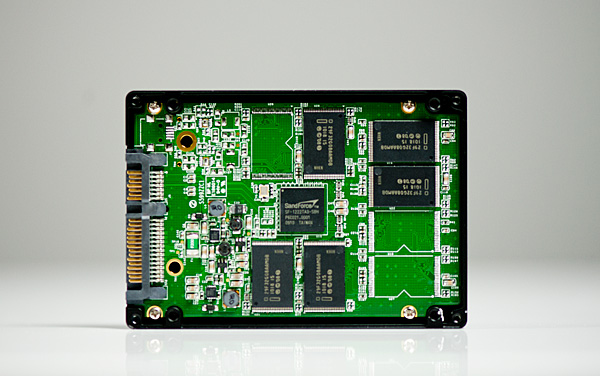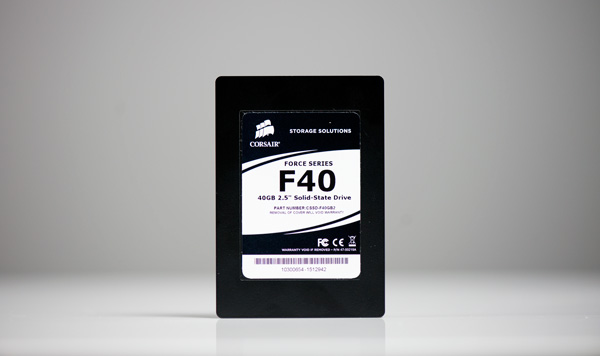Z68 SSD Caching with Corsair's F40 SandForce SSD
by Anand Lal Shimpi on May 13, 2011 3:06 AM ESTI have to admit that Intel's Z68 launch was somewhat anti-climactic for me. It was the chipset we all wanted when Sandy Bridge first arrived, but now four months after Sandy Bridge showed up there isn't all that much to be excited about - save for one feature of course: Smart Response Technology (aka SSD caching). The premise is borrowed from how SSDs are sometimes used in the enterprise space: put a small, fast SSD in front of a large array of storage and use it to cache both reads and writes. This is ultimately how the memory hierarchy works - hide the latency of larger, cheaper storage by caching frequently used data in much faster, but more expensive storage.
I believe there's a real future with SSD caching, however the technology needs to go mainstream. It needs to be available on all chipsets, something we won't see until next year with Ivy Bridge. Even then, there's another hurdle: the price of the SSD cache.
Alongsize Z68 Intel introduced the SSD 311, codename Larson Creek. The 20GB SSD uses 34nm SLC NAND, thus pricing the drive more like a 40GB MLC SSD at $110. Intel claims that by using SLC NAND it can deliver the write performance necessary to function as a good cache. Our benchmarks showed just that. The 20GB SSD 311 performed a lot like a 160GB Intel X25-M but with half of the NAND channels thanks to SLC NAND's faster write speed and some firmware tweaks. In fact, the only two complaints I had about the 311 were its limited capacity and price.
The capacity issue proved to be a problem as I found that after almost a dozen different application launches it wasn't too hard to evict useful data from the cache. The price is also a problem because for $100 more you can pick up a 120GB Vertex 2 and manage your data manually with much better performance overall.
Yesterday a friend pointed me at a now defunct deal at Newegg. For $85 Newegg would sell you a 40GB SF-1200 based Corsair Force SSD. That particular deal is done with and all that remains is the drive for $110, but it made me wonder - how well would a small SandForce drive do as an SSD cache? There's only one way to find out.

The Test
| CPU |
Intel Core i7 2600K running at 3.4GHz (Turbo & EIST Disabled) - for AT SB 2011, AS SSD & ATTO |
| Motherboard: |
Intel Z68 Motherboard |
| Chipset: |
Intel Z68 |
| Chipset Drivers: |
Intel 9.1.1.1015 + Intel RST 10.5 |
| Memory: | Qimonda DDR3-1333 4 x 1GB (7-7-7-20) |
| Video Card: | Intel HD Graphics 3000 |
| Video Drivers: | Intel GMA Driver for Windows 8.15.10.2372 |
| Desktop Resolution: | 1920 x 1200 |
| OS: | Windows 7 x64 |












81 Comments
View All Comments
Dribble - Friday, May 13, 2011 - link
The reason being they are so common they are cheap. In the UK you can't get that 20GB Intel SSD yet, and while you could get the 40GB force (or vertex 2) the cost difference is very small - like I did you might as well get the 60GB vertex 2. I suspect a few others will do the same thing.Hence it would seem a good test.
The other thing I'd like to know is if you can buy a large capacity SSD (e.g. 240GB vertex 3) and then partition it giving 180GB to use as a boot drive, and the other 60GB to cache your monster games disk.
10Goto10 - Friday, May 13, 2011 - link
Or a 6Gb Sata Vertex3 240 GB, it should have enough IO, throughput and space to maintain both os and cache.Ryan Smith - Friday, May 13, 2011 - link
Yes, you can partition SSDs. In fact we've thrown around the exact same idea.10Goto10 - Friday, May 13, 2011 - link
According to the test hardware spec, the test is run on H67 not Z68, copy paste ;) ??mschira - Friday, May 13, 2011 - link
Would it be possible to get some SSD caching on a thinkpad t-series? they not only have a normal hard drive slot but they also have a miniPci slot for which they explicetly support small SSD to mount there...now having SSD caching would be great...
M.
DanNeely - Friday, May 13, 2011 - link
First page, the table lists an h67 mobo for the test, not a Z68jdavenport608 - Friday, May 13, 2011 - link
Both your articles about Z68 mention that SSD caching can be used in front of a RAID array. Do you plan on doing an article that describes the benefits or value of using a SSD cache in conjunction with different RAID arrays?weh69 - Friday, May 13, 2011 - link
I'd love to see results for a 60GB SSD as cache in front of a dual 2TB WD black RAID-1 array as the system drive.hechacker1 - Friday, May 13, 2011 - link
If that is possible, I would really like to see that too.Especially for a raid-5 config. Since write performance is limited so much by parity writes, having a cache could really help (on maximum mode).
kepstin - Friday, May 13, 2011 - link
This Intel SSD caching feature is a bit disappointing in one way.It's obvious that the caching work is done completely in software - in the Windows chipset driver, the same way as the motherboard RAID features work. There probably is some BIOS support required to boot off it though.
There's no technical reason why the same technology couldn't be used on other chipsets - it's just that Intel's decided to artificially limit it to the Z68...
I wouldn't be surprised if third-party tools and a generic Linux driver that can do the same thing on any chipset start showing up later this year.